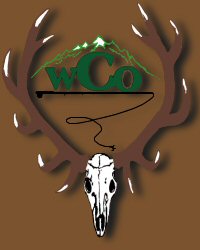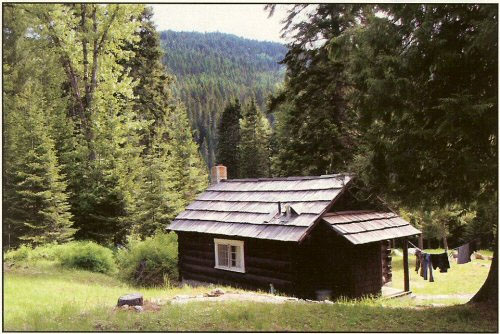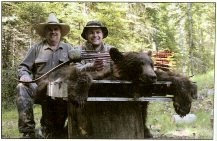
Home
About Us
Fly Fishing
Bear Hunting
Cougar and Bobcat Hunting
Accommodations Info
Arriving & Departing Info
Booking Request & Info
Traditional Bowhunter Article

Weitas Creek Outfitters
211 Winona Road
Kamiah, Idaho 83536
(208) 983-9267
info@idahooutfitter.com
Traditional Bowhunter Magazine Article
April/May 2008 Edition
CLEARWATER NATIONAL
FOREST, IDAHO
Weitas Creek Outfitters:
A Bear Hunting Adventure You Won't Forgetby Ron Rohrbaugh
Working in strict silence, Gary gestured with his right hand to a small pile of sticks covering a gallon-sized mound of dog food soaked with used cooking oil. The bait was so discreet that you might walk by it if you didn't know it was there. With his left hand he pointed to a slight depression just eight yards from the pile of sticks and I slipped into the natural pit blind to test it out. Kneeling on the wet earth with only a burned out stump and a Douglas fir sapling for cover, I felt as if I could spit on any bear visiting the site. Looking in Gary's direction I raised my eyebrows and smirked, hoping to convey amusement tinged with a small dose of concern. After all, these were bears that I would be facing nose to nose. Gary seemed unphased. He gave a wry smile and nodded before disappearing over the hill toward the road.
Sleet and cold rain pelted my face as I settled into my makeshift blind. With some trepidation, I cinched my raincoat's hood around my face and hoped I didn't look too much like a human-flavored bear snack. I nocked an arrow on my longbow's string and wondered if I'd be able to smell an old bear's breath from this distance.
Owned and operated by Gary and Sue Haight, Weitas Creek Outfitters in north-central Idaho specialized in bear and elk hunts for traditional bowhunters. Gary is a stickbow hunter himself and knows what it takes to be successful with traditional tackle. Their area in the Clearwater National Forest permits hunters to take two bears. The Weitas Creek portion of the 1.8 million acre Clearwater isn't considered an official Wilderness area, but it could be. The slopes and tributaries surrounding Weitas Creek are as remote and wild as it gets. Getting there requires a long drive from the town of Kamiah to the high point at Beaver Dam Saddle. The remaining 15 mile trip to the camp is made by snow machine, mule, or ATV depending on the conditions.
Gary's posture and wide-brimmed cowboy hat tell the story of a man who has spent a lifetime working with horses. In fact, during fall hunts he uses his own stable of mules to pack hunters and gear into the backcountry. When I was thee in late May thee was still more than three feet of snow at Beaver Dam Saddle, preventing us from using mules and requiring a snow machine, fondly named Sponge Bob, to travel over the saddle. Spring bear hunts are conducted from the Weitas Creek Guard Station, a comfortable Forest Service facility with a cooking/dining lodge and three small cabins for sleeping. There is no electricity, but gravity fed water and propane appliances supply some comforts of home. To make the best of the available space Gary and Sue usually limit the number of hunters to five, but they agreed to host me as a last minute addition to the hunt, bringing our group to six. The other five hunters were from the Seattle area and for all but one this was their first bear hunt.
The Clearwater is rich in natural and cultural history as well as wildlife. The historic Lolo trail used by the Lewis and Clark expedition in September 1805 transects the forest and there are a number of sites of Native American historical significance. Referring to a peak near the Lolo trail, William Clark wrote: "From this mountain I could observe high rugged mountains in every direction as far as I could see." It's a bit awe inspiring to walk the same ridges as the Corps of Discovery and the great Nez Perce tribe. It's also thrilling to see such tremendous wildlife diversity, including elk, mule deer, whitetails, wolves, and myriad bird and small mammal species.
Spring bear hunting has its own daily rhythms. The nights are long, the mornings as lazy as you want them to be. We wiled ours away bird watching, shooting bows, or simply sleeping in. I especially enjoyed running morning baits with the guides, which taught me a lot about bear hunting and the local area. Gary is a quiet guy, but makes up for his reserve with a wry sense of humor and expert knowledge of all things Idaho. Those who get to know him will be rewarded with a wealth of information from a savvy hunter and naturalist.
While morning around camp are mellow, afternoons are punctuated with intensity. This hunt isn't for the faint of heart. Gary offers both spot and stalk and bait hunting. While spot and stalk would seem the more exciting, it is only feasible in a few of the less forested locations. Most of the area is too overgrown to allow seeing bears at a distance. At first I was a bit disappointed by this, but I quickly learned how challenging and exciting Gary's style of bait hunting could be. Most of the set ups are skimpy natural ground blinds positioned just 5 to 15 yards from the bait; a few have treestands that are even closer. Gary likes to put his hunters in easy stickbow range. It's psychologically demanding to keep it together when you're on the ground with bears mere feet away. If you watch TV or videos you might get the impression that bears over bait are a bit like fish in a barrel, but not so at Weitas Creek. These are wild bears that don't tolerate movement or noise, so it's imperative to stay focused and ready.
Central Idaho bears aren't big compared to their coastal Alaskan or Saskatchewan relatives, but they still bring on the heart-pounding thrill of hunting semi-dangerous game. The average bear is 175 pounds and big ones run in the 250-350 pound range. Color phase bears are common in this region and 40% of the bears taken at Weitas creek are some shade of brown. Two of the three bears shot during my stay were a beautiful chocolate color.
About midway through my week-long hunt, I accompanied Gary while he dropped off two other hunters, Ian and Even, at their baits before settling into the ground blind I described earlier. Bears has appeared consistently in Ian's area and the anticipation showed on his face. Despite his youth, Ian is an experienced hunter who originally hails from Colorado. He'd never hunted bears before and his eagerness was clear as he guided his lanky body up the tree and hoisted his recurve. We gave him the thumbs up and quietly headed for the road. Thirty-minutes later I was hunkered in my little depression, wondering what sights the Idaho wilderness would bring my way.
Gary and Ian share a photo with Ian's chocolate-phase bear.Around 3:30 I heard a twig snap and looked over my left shoulder to see a cow elk slipping through the cover below me. Thirty minutes later I caught movement again and thought it was the elk, but quickly realized that a black bear was making its way up the slope towards me. From 40 yards he glanced my way, but seemed to look right through me. The 150-pounder toyed with the sticks covering the bait while I tried to decide whether to shoot him or hold out for something bigger. Before I could make my decision, the bear made it by walking straight at me. I knelt with my bow pointed in the bear's direction and a fair bit of tension on the bowstring. He silently padded over the wet ground and up onto a charred log that connected to the stump I was hiding behind. Walking the log like a gymnast on a balance beam, he approached to eight feet and we stared eye to eye. I could see his nostrils working to discern what his eyes could not. After a 15-second standoff, the bear charged forward before he disappeared over the steep ridge. Moments later a second, larger bear skirted the ridge to my left, but didn't approach the bait. By the time the jackhammer in my chest finally let up I knew I was hooked on Gary's style of bear hunting. At dark, I cautiously picked my way through the timber and back to the road.
I was pretty sure that something was up when the evening chorus of Swainson's and varied thrushes had come and gone without anyone arriving to fetch me from the roadside. Another hour passed while I read Fred Bear's biography by headlamp, but still no one showed up. I was certain that a bear was down. The only question was who had done the shooting. Soon I heard the sound of tires on dirt. The mystery was solved when the car's interior light revealed Ian beaming from the back seat. He'd missed a big black bear early in the afternoon, but then made good on a point blank shot at a beautiful chocolate-phase bear.
In the end, I left Idaho without a bear; mostly because of rainy, cold conditions that limited bear movement and made hunting difficult. I have no reluctance, however, about recommending this hunt to traditional bowhunters. The combination of unspoiled wilderness, rich history, and great people make this hunt well worth the price of admission. Add to that the opportunity to hunt bears up close and personal and you have a traditional bowhunting destination of the highest caliber (or maybe that should be sharpest broadhead?).
An ornithologist with Cornell University in New York, Ron Rohrbaugh contributes frequently to the magazine.
also specializing in winter mountain lion hunts, spring and fall bear hunts, fall trophy elk hunts, and remote summer fly fishing trips.
2024 All Rights Reserved


